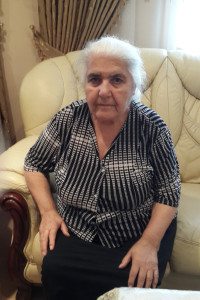STRASBOURG, France (A.W.)—Earlier this month, the European Court of Human Rights (ECHR) ruled on two lawsuits filed by Armenian and Azerbaijani former residents of areas around Nagorno-Karabagh, who were displaced during the war. At a public hearing in Strasbourg on June 16, ECHR Grand Chamber judgments were delivered in the cases of “Sargsyan v. Azerbaijan” and “Chiragov and Others v. Armenia.”
The Middlesex University-based European Human Rights Advocacy Center (EHRAC), along with an Armenian NGO called Legal Guide, is defending the Sargsyan family. According to Professor Phillip Leach, director of EHRAC, these ground-breaking parallel cases may have “exceptional significance” for over a million internally displaced people in Armenia and Azerbaijan.
“Over a million people, both Armenian and Azerbaijani, have been displaced by the conflict, and these judgments are significant in establishing that the two governments must take action to secure the rights of internally displaced people and refugees,” Philip said in a statement after the ruling. “After 27 years of conflict, the Court is sending a resounding message that it’s time for the hostile rhetoric to stop and for the rights of the civilian victims of the conflict to be actively upheld.”
Sargsyan v. Azerbaijan
The applicant, Minas Sargsyan, an Armenian national, was born in 1929 and passed away in 2009 in Yerevan. He filed his complaint with the ECHR in 2006, and since his passing, two of his children have pursued the application on his behalf.
According to his application, Sargsyan had stated that he and his family, ethnic Armenians, used to live in the village of Gulistan, in the Shahumyan region of the Azerbaijan SSR, where he had a house and a plot of land. His family was forced to flee from their home in 1992 during the Armenian-Azerbaijani conflict over Nagorno-Karabagh.
The press release issued by the Registrar of the Court following the ruling outlined Sargsyan’s complaints, which were filed in August 2006, and included violations on the protection of property, the right to respect for private and family life, right to an effective remedy, and prohibition of discrimination:
Mr. Sargsyan complained that the denial by the Azerbaijani Government of his right to return to the village of Gulistan and to have access to, control, use and enjoy his property or to be compensated for its loss amounted to a continuing violation of Article 1 of Protocol No. 1 (protection of property) to the European Convention on Human Rights. He further complained that the denial of his right to return to Gulistan and have access to his home and to the graves of his relatives constituted a continuing violation of Article 8 (right to respect for private and family life) of the Convention. Relying on Article 13 (right to an effective remedy) of the Convention, in conjunction with the other complaints, he further complained that no effective remedy was available to him. Lastly, he submitted under Article 14 (prohibition of discrimination), in conjunction with the other complaints, that he had been discriminated against on the basis of his ethnic origin and religious affiliation.
On June 16, the Court found that Azerbaijan had violated the property rights of Sargsyan, who had been forced to flee his home during the war. The case, according to the EHRAC, has implications for “hundreds of thousands of people in the same situation,” who could stand to receive compensation or “other redress.”
Chiragov and Others v. Armenia
The applicants Elkhan Chiragov, Adishirin Chiragov, Ramiz Gebrayilov, Akif Hasanof, Fekhreddin Pashayev, and Qaraca Gabrayilov—all Azerbaijani nationals—stated that they are Azerbaijani Kurds who lived in the district of Lachin and were unable to return to their homes and property there, after having been forced to leave during the war.
One of the applicants, Ramiz Gabrayilov, died in 2005, and his son has pursued the application on his behalf.
The applicants’ complaints, filed in April 2005, focused on the same violations outlined in the parallel Sargsyan v. Azerbaijan case:
The applicants complained that the loss of all control over, and of all potential to use, sell, bequeath, mortgage, develop and enjoy their properties in Lachin amounted to a continuing violation of Article 1 of Protocol No. 1 (protection of property) to the European Convention on Human Rights. They also complained that their inability to return to the district of Lachin constituted a continuing violation of Article 8 (right to respect for home and private and family life) of the Convention. Furthermore, they complained that no effective remedies had been available to them in respect of their complaints, in breach of Article 13 (right to an effective remedy). Finally, they submitted that, in relation to the other complaints, they had been discriminated against on the basis of their ethnic origin and religious affiliation, in violation of Article 14 (prohibition of discrimination).
The Court found on the same day as the “Sargsyan v. Azerbaijan” ruling that Armenia had violated the same Articles of the European Convention with respect to the nine applicants in the case.
Future Prospects
According to the EHRAC, the judgments in the two cases have the potential to “reinvigorate negotiations for a political settlement over the Nagorno-Karabagh region.” In its ruling, the Court stated that “the mere fact that peace negotiations are ongoing [under the auspices of the OSCE] does not absolve the Government from taking other measures, especially when negotiations have been pending for such a long time.”
The judgment also called on the Governments of Armenia and Azerbaijan to establish a property claims mechanism that would be “easily accessible to allow the applicants and others in their situation to have their property rights restored and to obtain compensation for the loss of the enjoyment of their rights.”
The post European Court Delivers Ruling in Parallel Cases Filed by Armenians and Azerbaijanis appeared first on Armenian Weekly.



















